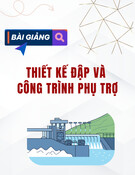
* Corresponding author.
E-mail addresses: shaloosharma2673@gmail.com (S. Devi)
© 2017 Growing Science Ltd. All rights reserved.
doi: 10.5267/j.esm.2017.9.001
Engineering Solid Mechanics (2017) 271-284
Contents lists available at GrowingScience
Engineering Solid Mechanics
homepage: www.GrowingScience.com/esm
Eigenvalue approach to nanoscale beam in modified couple stress thermo-elastic
diffusion
Rajneesh Kumara and Shaloo Devib*
aDepartment of Mathematics, Kurukshetra University, Kurukshetra, India
bDepartment of Mathematics & Statistics, Himachal Pradesh University, Shimla, India
A R T I C L EI N F O A B S T R A C T
Article history:
Received 6 June, 2017
Accepted 7 September 2017
Available online
7 September 2017
The problem of thermoelastic nanoscale beam based on a modified couple stress theory with
diffusion subjected to ramp type heating is investigated. The Laplace transform technique and
eigen value approach are applied to solve the equations which are written in the dimensionless
form. The expressions for displacement, lateral deflection, temperature change, mass
concentration, axial stress and chemical potential are derived in the transformed domain. A
general algorithm of the inverse Laplace transform is developed to compute the results
numerically. The mathematical model is prepared for Copper material. The resulting quantities
are depicted graphically to show the effects of time. Some particular cases of interest are also
deduced from the present problem.
© 2017 Growing Science Ltd. All rights reserved.
Keywords:
Modified couple stress theory
Thermoelastic diffusion
Nanoscale beam
Laplace transform
Eigen value approach
Ramp type heating
1. Introduction
Voigt (1887) was the first who introduced the concept of couple stress linear theory of elasticity and
then this theories extended by Cosserat and Cosserat (1909). Couple-stress theory is an extended
continuum theory that includes the effects of a couple per unit area on a material volume, in addition
to the classical direct and shear forces per unit area. This immediately admits the possibility of
asymmetric stress tensor, since shear stress no longer have to be conjugate in order to ensure rotational
equilibrium. Toupin (1962) derived the associative constitutive equations for finite deformation of
perfectly elastic materials. Mindlin and Tiersten (1962) formulated a linearized theory of couple stress
elasticity. Making use of this theory by Mindlin and Tiersten (1962), the effect of couple stresses were
studied on surface waves in elastic media and propagation of waves in an elastic layer by Sengupta and
Ghosh (1974a, 1974b). Yang et al. (2002) modified the classical couple stress theory and proposed a
modified couple-stress model, in which the couple stress tensor is symmetrical and only one material

272
length parameter is needed to capture the size effect which is caused by micro-structure. Simsek and
Reddy (2013) investigated the bending and vibration of functionally graded microbeams using a new
higher order beam theory and the modified couple stress theory. Recently, Shaat et al. (2014) studied
the size-dependent bending analysis of Kirchhoff nano-plates based on a modified couple-stress theory
including surface effects. Samaei et al. (2015), analyzed vibration response of a graphene sheet
embedded in an elastic medium and considered the small scale effects in this regard.
Thermo-diffusion is used to describe the processes of thermomechanical treatment of metals
(carboning, nitriding steel, etc.) and these processes are thermally activated, and their diffusing
substances being, e.g. nitrogen, carbon etc. They are accompanied by deformations of the solid. The
theory of thermoelastic with mass diffusion was firstly developed by Nowacki (1974). In this theory,
the coupled thermoelastic model is used. This implies infinite speeds of propagation of thermoelastic
waves. Sherief et al. (2004) developed the theory of generalized thermoelastic diffusion that predicts
finite speeds of propagation for thermoelastic and diffusive waves. Sherief and Saleh (2005) worked
on a problem of a thermoelastic half space with a permeating substance in contact with the bounding
plane in the context of the theory of generalized thermoelastic diffusion with one relaxation time. The
basic equations in generalized thermoelastic diffusion for Green Lindsay (GL-model) theory was
derived by Kumar and Kansal (2008).
The significance of using eigenvalue approach to reduce the problem on vector-matrix differential
equation to an algebraic eigenvalue problems. Thus the solutions for the field variables are obtained by
determining the eigenvalues and the corresponding eigenvectors. In this approach, the physical
quantities are directly involved in the formulation of the problem and as such the boundary and initial
conditions can be applied directly. Choudhary and Deswal (2010) studied the two-dimensional problem
of generalized thermoelastic diffusion using the eigenvalue approach. Sarkar and Lahiri (2012)
discussed the two-temperature magnetothermoelastic problem in the context of one relaxation time.
The Laplace transform and eigenvalue approach are used to solve the basic equations. Zang and Fu
(2012) developed a new beam model for a viscoelastic micro-beam based on a modified couple stress
theory. Rezazadeh et al. (2012) discussed problem of thermoelastic damping in a micro-beam resonator
using modified couple stress theory. Abouelregal and Zenkour (2014) discussed the problem of an
axially moving microbeam subjected to sinusoidal pulse heating and an external transverse excitation
with one relaxation time by using Laplace transform and also studied the effects of the pulse-width of
thermal vibration, moving speed and the transverse excitation. Yong et al. (2015) presented a nonlinear
bending and post-buckling of extensible microscale beams based on modified couple stress theory
where the effects of the material length scale parameter and the Poisson ratio on the bending and
thermal post-buckling behaviors of microbeams are discussed in detail. Kumar and Devi (2015)
presented the problem of hall current and rotation in a modified couple stress theory due to ramp type
loading. Thermoelastic interaction in a thermally conducting cubic crystal subjected to ramp–type
heating was investigated by Abbas et al. (2015). Reddy et al. (2016) discussed the problem of
functionally graded circular plates with modified couple stress theory by using finite element method.
On the basis of global local theory, a model for a composite laminated Reddy plate of new modified
couple-stress theory was developed by Chen and Wang (2016). Zenkour and Abouelregal (2016)
discussed the vibration of functionally graded microbeams by using Green–Naghdi thermoelasticity
theory (1993) and Laplace transform.
In this work, the governing equations of the modified couple stress theory of thermoelastic beam
induced by ramp-type heating is developed. The basic equations are solved by applying Laplace
transform technique and eigenvalue approach. Analytical method is used to determine the lateral
deflection, displacement, temperature change, mass concentration, chemical potential and axial stress
of the beam. The effects of time on the field quantities are studied and shown graphically.

R. Kumar and S. Devi / Engineering Solid Mechanics 5 (2017)
273
2. Basic equations
The constitutive relations, equations of motion, equation of heat conduction, equation of mass diffusion
in a modified couple-stress generalized thermoelastic with mass diffusion in the absence of body forces,
body couples, heat and mass diffusive sources are given by Yang et al. (2002), Sherief et al. (2004).
12
1
2 - - - ,
2
ij ij ij kij lk,l ij ij
te e em T C
(1)
2,
ij ij
m
(2)
,
1,
2
ij i j j,i
, , 1, 2, 3. ijk
(3)
,
1,
2
iipqqp
eu
(4)
2,
kk
P
eaTbC
(5)
2
12
.,
44
TC
..
uu u
(6)
2
0001
2.0,
e
KT cT aTC T
tt
u
(7)
2
21
2
.0,DDaTDbC C
tt
u
(8)
where ij
t are the components of stress tensor,
and
are material constants, ij
is Kronecker’s delta,
ij
eare the components of strain tensor, ijk
eis alternate tensor,ij
mare the components of couple-stress,
t
23
1 ,
c
23
2 ,Here t
,c
are the coefficients of linear thermal expansion and
diffusion expansion respectively, T is the temperature change, C is the mass concentration,
is the
couple stress parameter, ij
is symmetric curvature, i
is the rotational vector,P is the chemical
potential of the material per unit mass, b is the coefficient describing the measure of mass diffusion
effects, a is the coefficient describing the measure of thermoelastic diffusion. u is the displacement
vector,
is the density, is the Laplacian operator,
is del operator.
K
is the coefficient of the
thermal conductivity, e
c is the specific heat at constant strain, 0
T is the reference temperature assumed
to be such that 01/TT .
D
is the thermoelastic diffusion constant, Here 0
are thermal relaxation
time and 1
are the diffusion relaxation time.
3. Formulation of the problem
We consider a homogeneous, isotropic, rectangular modified couple stress thermoelastic-diffusive
beam with dimensions of length
0,
x
L width
22dyd//
and thickness
22hzh//
as shown in Fig. 1. We define the
x
axis along the length of the beam, and the yaxis along the
width and zaxes along the thickness which also represent the axis of material symmetry. Thus, any
plane cross-section initially perpendicular to the axis of the beam remains plane and perpendicular to
the neutral surface during bending.

274
Fig. 1. Problem Description
According to the fundamental Euler-Bernoulli theory for small deflection of a simple bending problem,
the displacement components are given by
, 0, , , , , ,
w
uz v wx
y
zt wxt
x
(9)
where
,wxtis the lateral deflection of the beam and t is the time. The constitutive Eq. (1) in one-
dimension along the axis and with the help of Eq. (9), we obtain
2
12
2
2
x
w
tzTC
x
.
(10)
Then the bending moment of the cross-section of the beam is given by
22
22
hh
mx xy
hh
M
MM dtzdz mdz
,
(11)
where
M
and m
M
are the components of the bending moment due to the classic stress and couple
stress tensors respectively.
Using Euler-Bernoulli assumption (9) and with the aid of Eq. (10) in Eq. (11), yields
22
22
2,
TC
ww
MIMMA
x
x
(12)
where Iis the second moment of the cross-section area of the beam, T
M
is the thermal moment, C
M
is the mass moments of the beam. Thus, ,IT
M
and C
M
are given by
3
222
2
12
222
, , .
12
hhh
TC
hhh
dh
I dzdz M d Tzdz M d Czdz
(13)
ܮ
݀
݄
ݕ
ݔ
ݖ

R. Kumar and S. Devi / Engineering Solid Mechanics 5 (2017)
275
The equation of transverse motion of the beam is given by Rao (2007):
22
22
0,
Mw
A
x
t
(14)
where
denotes the beam density and
A
dh
is the cross –sectional area of the beam.
Substituting Eqs. (12) in Eq. (14), we obtain
2
2
42
42 2 2
20
C
TM
M
ww
IA A
x
xx t
. (15)
The heat conduction equation and the mass diffusion equation can be written as
22 2 2
0010
22 2 2
0,
e
TT w
KcTaTCTz
xz t t x
(16)
422 2 22
21
422 2 22
0
wTT TT
Dz Da CDb
xxztt xz
.(17)
For a very thin beam, assuming the temperature increment and mass concentration varies in terms of
()
s
in pz function along the thickness of the beam.
1
,, , ( ),Txzt=Txtsinpz
1
,, , ( ),Cxzt=C xtsinpz (18)
where .p= h
Multiplying Eq. (16) and Eq. (17) by zdz
and integrate over the interval
2, 2//hh, we obtain
2
222
2010
1
10 11
22 2
=0,
24
e
caT Th
Tw
pT T C
xttKKKx
(19)
22 2
42
22
21 1
111 1
42 2 2
=0.
24
Dh T C
wDa p T C Db p C
xx tt x
(20)
For convenience, we define the following dimensionless quantities:
01
01
00 0
2
222
,,,
,,, , , , , , , ,
, , , , .
Cx
T
TCx
xzuw tTC P
xzuw t T C P
L
LLLTCbC
Mt
M
ME
MM M t
dEh dEh dEh E
''' ' ' ' ' ' ' '
'' ''
(21)
Using Eqs. (18) and Eqs. (21), with the aid of Eq. (13) in Eq. (15), Eq. (19) and Eq. (20), after dropping
the dashes for convenience, yield
22
42
11
12 3
42 2 2
0,
TC
ww
aa a
xx x t
(22)


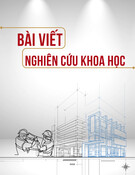
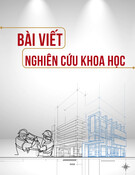

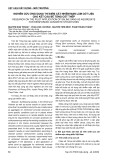

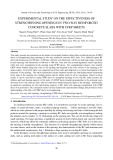
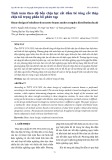

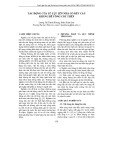




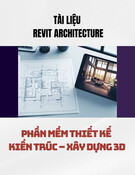


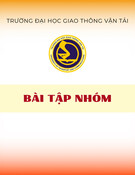

![Bài giảng Quản lý vận hành và bảo trì công trình xây dựng [chuẩn nhất]](https://cdn.tailieu.vn/images/document/thumbnail/2025/20251006/agonars97/135x160/30881759736164.jpg)
